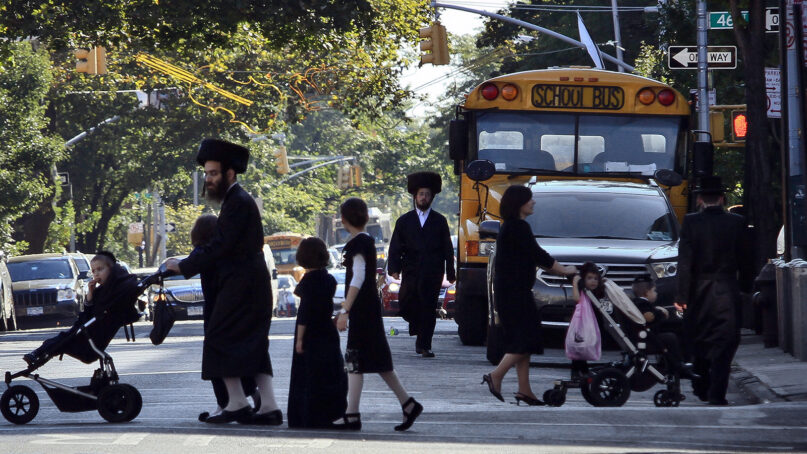(RNS) — Let’s assume, as I did in my last column, that Hasidic groups in New York will take the state to court for attempting to enforce a law requiring their yeshivas to give students an education “substantially equivalent” to what the public schools provide.
In that case, the relevant Supreme Court decision will be Wisconsin v. Yoder, in which a unanimous Supreme Court decided 50 years ago that Amish children did not have to attend public schools past the eighth grade.
The decision, written by then-Chief Justice Warren Burger, is widely understood as establishing that the parents’ right to religious free exercise supersedes the state’s interest in educating their children. But that view fails to appreciate the careful balancing of interests that Burger undertook.
“There is no doubt as to the power of a State, having a high responsibility for education of its citizens, to impose reasonable regulations for the control and duration of basic education,” Burger wrote. In deference to this principle, the decision made clear why Amish religion was threatened by high school but not elementary school.
Amish objection to formal education beyond the eighth grade is firmly grounded in these central religious concepts. They object to the high school, and higher education generally, because the values they teach are in marked variance with Amish values and the Amish way of life; they view secondary school education as an impermissible exposure of their children to a ‘wordly’ influence in conflict with their beliefs. The high school tends to emphasize intellectual and scientific accomplishments, self-distinction, competitiveness, worldly success, and social life with other students. Amish society emphasizes informal learning-through-doing; a life of ‘goodness,’ rather than a life of intellect; wisdom, rather than technical knowledge; community welfare, rather than competition; and separation from, rather than integration with, contemporary worldly society.
By contrast, wrote Burger, “The Amish do not object to elementary education through the first eight grades as a general proposition because they agree that their children must have basic skills in the ‘three R’s’ in order to read the Bible, to be good farmers and citizens, and to be able to deal with non-Amish people when necessary in the course of daily affairs.”
In reaching its judgment, the court reviewed the history of Amish beliefs and practices to determine that the plaintiffs in fact met the judicial requirement that they hold their views sincerely. “It cannot be overemphasized that we are not dealing with a way of life and mode of education by a group claiming to have recently discovered some ‘progressive’ or more enlightened process for rearing children for modern life,” Burger wrote.
This determination of sincerity did risk running afoul of the establishment clause in that it employed certain criteria to decide what amounted to a “legitimate” religion entitled to the full protection of the First Amendment. A concurring opinion written by Byron White and joined by William Douglas and Potter Stewart acknowledged the risk.
“Decision in cases such as this and the administration of an exemption for Old Order Amish from the State’s compulsory school-attendance laws will inevitably involve the kind of close and perhaps repeated scrutiny of religious practices, as is exemplified in today’s opinion, which the Court has heretofore been anxious to avoid,” wrote White. “But such entanglement does not create a forbidden establishment of religion where it is essential to implement free exercise values threatened by an otherwise neutral program instituted to foster some permissible, nonreligious state objective.”
On its face, it’s hard to imagine the Yoder court finding in favor of the New York Hasidim. The New York Times’ discovery that 99% of the boys in their Yeshivas failed state tests administered in the third and eighth grades (and barely knew English) shows precisely that the Hasidic schools are failing to provide the kind of basic education the Yoder court deemed within the government’s right to mandate.
But that’s not to say today’s court would do the same. In case after free exercise case, a majority has conducted no comparable inquiry, taking any and all religiously based objections to laws as sufficiently sincere. If you doubt it, just take a look at the court’s treatment of recent free exercise claims to be exempt from COVID restrictions.
Here’s how the Yoder court justified its granting of relief to the plaintiffs:
Aided by a history of three centuries as an identifiable religious sect and a long history as a successful and self-sufficient segment of American society, the Amish in this case have convincingly demonstrated the sincerity of their religious beliefs, the interrelationship of belief with their mode of life, the vital role that belief and daily conduct play in the continued survival of Old Order Amish communities and their religious organization, and the hazards presented by the State’s enforcement of a statute generally valid as to others.
Would that the court still required such a demonstration in free exercise cases. One day, perhaps, it will.






